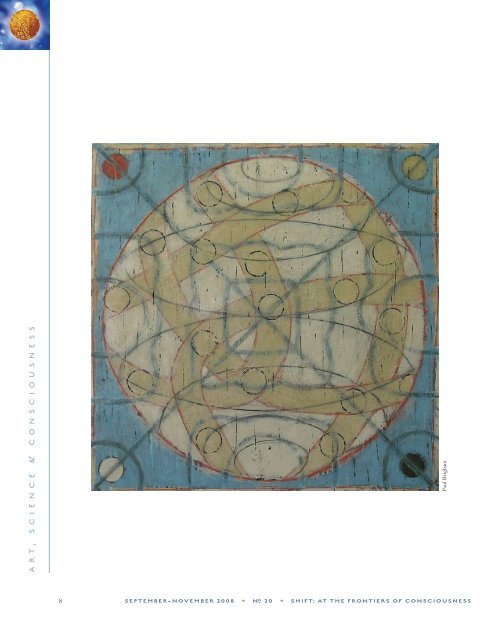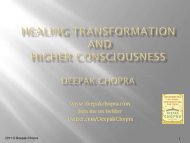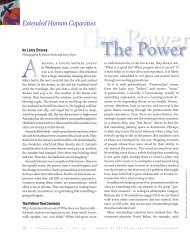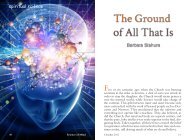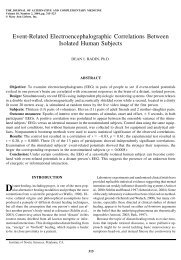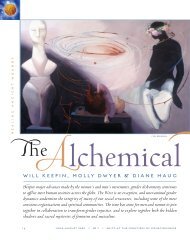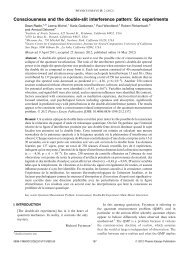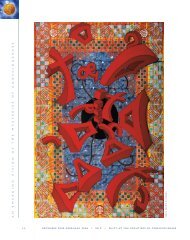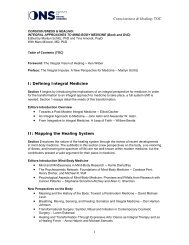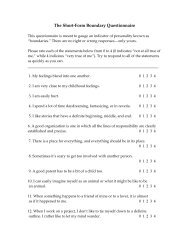Why Science Needs Art - Institute of Noetic Sciences
Why Science Needs Art - Institute of Noetic Sciences
Why Science Needs Art - Institute of Noetic Sciences
You also want an ePaper? Increase the reach of your titles
YUMPU automatically turns print PDFs into web optimized ePapers that Google loves.
A R T , S C I E N C E & C O N S C I O U S N E S S<br />
8 SEPTEMBER–NOVEMBER 2008 • # 20 • SHIFT: AT THE FRONTIERS OF CONSCIOUSNESS<br />
Paul Brigham
In the early 1920s, Niels Bohr was struggling<br />
to reimagine the structure <strong>of</strong> matter. Previous<br />
generations <strong>of</strong> physicists had thought the inner space<br />
<strong>of</strong> an atom looked like a miniature solar system with the<br />
atomic nucleus as the sun and the whirring electrons as<br />
planets in orbit. This was the classical model.<br />
But Bohr had spent time analyzing the radiation<br />
emitted by electrons, and he realized that science needed<br />
a new metaphor. The behavior <strong>of</strong> electrons seemed to<br />
defy every conventional explanation. As Bohr said,<br />
“When it comes to atoms, language can be used only as<br />
in poetry.” Ordinary words couldn’t capture the data.<br />
Bohr had long been fascinated by cubist paintings. For<br />
him, the allure <strong>of</strong> cubism was that it shattered the certainty<br />
<strong>of</strong> the object. The art revealed the fissures in everything,<br />
turning the solidity <strong>of</strong> matter into a surreal blur.<br />
Bohr’s discerning conviction was that the invisible<br />
When we think about the scientific process, a specific<br />
vocabulary comes to mind: objectivity, experiments,<br />
facts. In the passive tense <strong>of</strong> the scientific paper, we<br />
imagine a perfect reflection <strong>of</strong> the real world. Paintings<br />
can be pr<strong>of</strong>ound, but they are always pretend.<br />
This view <strong>of</strong> science as the sole mediator <strong>of</strong> everything<br />
depends upon one unstated assumption: Scientific<br />
knowledge is a linear ascent. The history <strong>of</strong> science is<br />
supposed to obey a simple equation: Time plus data<br />
equals understanding. One day, we believe, science will<br />
solve everything.<br />
But the trajectory <strong>of</strong> science has proven to be a little more<br />
complicated. The more we know about reality—about<br />
its quantum mechanics and neural origins—the more<br />
palpable its paradoxes become. As Vladimir Nabokov, the<br />
novelist and lepidopterist, once put it, “The greater one’s<br />
science, the deeper the sense <strong>of</strong> mystery.”<br />
<strong>Why</strong> <strong>Science</strong><br />
<strong>Needs</strong> <strong>Art</strong><br />
world <strong>of</strong> the electron was essentially a cubist world. By<br />
1923, Louis de Broglie had already determined that electrons<br />
could exist as either particles or waves. What Bohr<br />
maintained was that the form they took depended on how<br />
you looked at them. Their very nature was a consequence<br />
<strong>of</strong> our observation. This meant that electrons weren’t like<br />
little planets at all. Instead, they were like one <strong>of</strong> Picasso’s<br />
deconstructed guitars, a blur <strong>of</strong> brushstrokes that only<br />
made sense once you stared at it. The art that looked so<br />
strange was actually telling the truth.<br />
A DEEPENING MYSTERY<br />
It’s hard to believe that a work <strong>of</strong> abstract art might have<br />
actually affected the history <strong>of</strong> science. Cubism seems<br />
to have nothing in common with modern physics.<br />
JONAH lEHRER<br />
Consider, for example, the history <strong>of</strong> physics. Once<br />
upon a time, and more than once, physicists thought<br />
they had the universe solved. Some obscure details<br />
remained, but the basic structure <strong>of</strong> the cosmos was<br />
understood. Out <strong>of</strong> this naïveté, relativity theory<br />
emerged, fundamentally altering classical notions<br />
about the relationship <strong>of</strong> time and space. Then came<br />
Heisenberg’s uncertainty principle and the surreal<br />
revelations <strong>of</strong> quantum physics. String theorists, in their<br />
attempts to reconcile ever widening theoretical gaps,<br />
started talking about eleven dimensions. Dark matter<br />
still makes no sense. Modern physics knows so much<br />
more about the universe, but there is still so much it<br />
doesn’t understand. For the first time, some scientists<br />
are openly wondering if we, in fact, are incapable <strong>of</strong><br />
figuring out the cosmos.<br />
SHIFT: AT THE FRONTIERS OF CONSCIOUSNESS • # 20 • SEPTEMBER–NOVEMBER 2008 9
By taking artistic explorations seriously,<br />
neuroscientists can better understand the holistic<br />
properties they are trying to parse.<br />
Or look at neuroscience. Only a few decades ago,<br />
scientists were putting forth confident conjectures about<br />
“the bridging principle,” the neural event that would<br />
explain how the activity <strong>of</strong> our brain cells creates the<br />
subjective experience <strong>of</strong> consciousness. All sorts <strong>of</strong> bridges<br />
were proposed, from 40 Hz oscillations in the cerebral<br />
cortex to quantum coherence in microtubules. These<br />
were the biological processes that supposedly turned the<br />
water <strong>of</strong> the brain into the wine <strong>of</strong> the mind.<br />
But scientists don’t talk about these kinds <strong>of</strong> bridging<br />
principles these days. While neuroscience continues to<br />
make astonishing progress in learning about the details<br />
<strong>of</strong> the brain—we are a strange loop <strong>of</strong> kinase enzymes<br />
and synaptic chemistry—these details only highlight our<br />
enduring enigma, which is that we don’t experience these<br />
cellular details. It is ironic, but true: The one reality science<br />
cannot reduce is the only reality we will ever know.<br />
THE ART OF PANDEMONIUM<br />
The logic <strong>of</strong> reductionism implies that our selfconsciousness<br />
is really an elaborate illusion, an<br />
epiphenomenon generated by some electrical shudder in<br />
the frontal cortex. There is no ghost in the machine;<br />
there is only the vibration <strong>of</strong> the machinery. Your head<br />
contains 100 billion electrical cells, but not one <strong>of</strong> them<br />
is you, or knows or cares about you. In fact, you don’t<br />
even exist. The brain is nothing but an infinite regress <strong>of</strong><br />
matter, reducible to the callous laws <strong>of</strong> physics.<br />
The problem with this method is that it denies the<br />
very mystery it needs to solve. Neuroscience excels at<br />
unraveling the mind from the bottom up. But our selfconsciousness<br />
seems to require a top-down approach.<br />
As the novelist Richard Powers wrote, “If we knew<br />
the world only through synapses, how could we know<br />
the synapse?” The paradox <strong>of</strong> neuroscience is that its<br />
astonishing progress has exposed the limitations <strong>of</strong><br />
its paradigm, as reductionism has failed to solve our<br />
emergent mind. Much <strong>of</strong> our experiences remain outside<br />
its range.<br />
This world <strong>of</strong> human experience is the world <strong>of</strong> the<br />
arts. The novelist and the painter and the poet embrace<br />
those ephemeral aspects <strong>of</strong> the mind that cannot be<br />
reduced, or dissected, or translated into the activity <strong>of</strong> an<br />
acronym. They strive to capture life as it’s lived. As<br />
Virginia Woolf put it, the task <strong>of</strong> the novelist is to<br />
“examine for a moment an ordinary mind on an<br />
ordinary day . . . [tracing] the pattern, however disconnected<br />
and incoherent in appearance, which each sight<br />
or incident scores upon the consciousness.” She tried to<br />
describe the mind from the inside.<br />
Neuroscience has yet to capture this first-person<br />
perspective. Its reductionist approach has no place for<br />
the “I” at the center <strong>of</strong> everything. <strong>Art</strong>ists like Woolf,<br />
however, have been studying such emergent phenomena<br />
for centuries and have constructed elegant models <strong>of</strong><br />
human consciousness that manage to express the texture<br />
<strong>of</strong> our experience, distilling the details <strong>of</strong> real life into<br />
prose and plot. That’s why their novels have endured:<br />
because they feel true. And they feel true because they<br />
capture a layer <strong>of</strong> reality that reductionism cannot.<br />
By taking these artistic explorations seriously, neuroscientists<br />
can better understand the holistic properties<br />
they are trying to parse. Before you break something<br />
apart, it helps to know how it hangs together. In this<br />
sense, the arts are an incredibly rich data set, providing<br />
science with a glimpse into its blind spots. If neuroscience<br />
is ever going to discover the neural correlates<br />
<strong>of</strong> consciousness, or find the source <strong>of</strong> the self, or locate<br />
the cells <strong>of</strong> subjectivity—if it’s ever going to get beyond<br />
a glossary <strong>of</strong> our cortical parts—then it has to develop<br />
a new method, one that’s able to construct complex<br />
representations <strong>of</strong> the mind that aren’t built from the<br />
bottom up. Sometimes, the whole is best understood<br />
in terms <strong>of</strong> the whole. William James realized this first.<br />
The eight chapters that begin his epic 1890 textbook,<br />
The Principles <strong>of</strong> Psychology, describe the mind in the<br />
conventional third-person terms <strong>of</strong> the experimental<br />
psychologist. Everything changes, however, with<br />
chapter nine. James starts this section, “The Stream <strong>of</strong><br />
Thought,” with a warning: “We now begin our study<br />
<strong>of</strong> the mind from within.”<br />
10 SEPTEMBER–NOVEMBER 2008 • # 20 • SHIFT: AT THE FRONTIERS OF CONSCIOUSNESS
With that single sentence, as radical in sentiment as<br />
the modernist novel, James tried to shift the subject <strong>of</strong><br />
psychology. He disavowed any scientific method that<br />
tried to dissect the mind into a set <strong>of</strong> elemental units,<br />
be it sensations or synapses. Such a reductionist view is<br />
the opposite <strong>of</strong> science, James argued, since it ignores our<br />
actual reality.<br />
Modern science didn’t follow James’s lead. In the years<br />
after his textbook was published, a “New Psychology”<br />
was born, and this rigorous science had no need for<br />
Jamesian vagueness. It wanted to purge itself <strong>of</strong> anything<br />
that couldn’t be measured. The study <strong>of</strong> experience was<br />
banished from the laboratory.<br />
But artists continued creating their complex<br />
simulations <strong>of</strong> consciousness. They never gave up on<br />
the ineffable or detoured around experience because<br />
it was too difficult. They plunged straight into the<br />
pandemonium. No one demonstrates this better than<br />
James Joyce. In Ulysses, Joyce attempted to capture the<br />
mind’s present tense. Everything in the novel is seen<br />
not from the omniscient perspective <strong>of</strong> the author, but<br />
through the concave lenses <strong>of</strong> his imaginary characters.<br />
We eavesdrop on their internal soliloquies, as Bloom,<br />
Stephen, and Molly think about beauty, and death, and<br />
eggs in bed, and the number eight. This, Joyce says, is<br />
the broth <strong>of</strong> thought, the mind before punctuation, the<br />
stream <strong>of</strong> consciousness rendered on the page. Ulysses<br />
begins where William James left <strong>of</strong>f.<br />
Similarly, Samuel Taylor Coleridge, enchanted with<br />
opium, was writing poetry about the “the mind’s selfexperience<br />
in the act <strong>of</strong> thinking” long before there was<br />
even a science <strong>of</strong> the mind. Or look at the world <strong>of</strong> visual<br />
art. As the neuroscientist Semir Zeki notes, “<strong>Art</strong>ists<br />
[painters] are in some sense neurologists, studying the<br />
brain with techniques that are unique to them.” Monet’s<br />
haystacks appeal to us, in part, because he had a practical<br />
understanding <strong>of</strong> color perception. The drip paintings<br />
<strong>of</strong> Jackson Pollock resonate precisely because they excite<br />
some peculiar circuit <strong>of</strong> cells in the visual cortex. These<br />
painters reverse-engineered the brain, discovering the<br />
laws <strong>of</strong> seeing in order to captivate the eye.<br />
Of course, the standard response <strong>of</strong> science is that<br />
such art is too incoherent and imprecise for the scientific<br />
process. If it can’t be plotted on a line graph or<br />
condensed into variables, then it’s not worth taking into<br />
account. But isn’t such incoherence an essential aspect<br />
<strong>of</strong> the human mind? Isn’t our inner experience full <strong>of</strong><br />
gaps and non sequiturs and inexplicable feelings? In this<br />
sense, the messiness <strong>of</strong> the novel and the abstraction <strong>of</strong><br />
the painting are actually a mirror. As the poetry critic<br />
Randall Jarrell put it, “It is the contradictions in works<br />
<strong>of</strong> art which make them able to represent us—as logical<br />
and methodical generalizations cannot—our world and<br />
our selves, which are also full <strong>of</strong> contradictions.” Until<br />
science sees the brain from a more holistic perspective—and<br />
such a perspective might require the artistic<br />
imagination—our scientific theories will be detached<br />
from the way we see ourselves.<br />
SCIENCE AS METAPHOR<br />
At first glance, physics seems particularly remote from<br />
the subjective sphere <strong>of</strong> the arts. Its theories are extracted<br />
from arcane equations and the subatomic debris <strong>of</strong><br />
supercolliders. This science continually insists that our<br />
most basic intuitions about reality are actually illusions,<br />
a sad myth <strong>of</strong> the senses. <strong>Art</strong>ists rely on the imagination,<br />
but modern physics exceeds the imagination. To<br />
paraphrase Hamlet, there are more things in heaven and<br />
earth—dark matter, quarks, black holes—than could<br />
ever be dreamt up. A universe this strange could only<br />
be discovered.<br />
But the surreal nature <strong>of</strong> physics is precisely why it<br />
needs the help <strong>of</strong> artists. The science has progressed<br />
beyond our ability to understand it, at least in any literal<br />
sense. As Richard Feynman put it, “Our imagination is<br />
stretched to the utmost, not, as in fiction, to imagine<br />
things which are not really there, but just to comprehend<br />
those things which are there.” It’s a brute fact <strong>of</strong><br />
psychology that the human mind cannot comprehend<br />
the double-digit dimensions <strong>of</strong> string theory or the<br />
possibility <strong>of</strong> parallel universes. Our mind evolved in<br />
a simplified world, where matter is certain, time flows<br />
forward, and there are only three dimensions. When we<br />
venture beyond these innate intuitions, we are forced to<br />
resort to metaphor. This is the irony <strong>of</strong> modern physics: It<br />
seeks reality in its most fundamental form, and yet we are<br />
utterly incapable <strong>of</strong> comprehending these fundaments<br />
beyond the math we use to represent them. The only<br />
way to know the universe is through analogy.<br />
As a result, the history <strong>of</strong> physics is littered with<br />
metaphorical leaps. Einstein grasped relativity while<br />
SHIFT: AT THE FRONTIERS OF CONSCIOUSNESS • # 20 • SEPTEMBER–NOVEMBER 2008 11
The power <strong>of</strong> a metaphor<br />
is that it allows scientists to imagine<br />
the abstract concept in concrete terms.<br />
thinking about moving trains. <strong>Art</strong>hur Eddington<br />
compared the expansion <strong>of</strong> the universe to an inflated<br />
balloon. James Clerk Maxwell thought <strong>of</strong> magnetic<br />
fields as little whirlpools in space, which he called<br />
vortices. The big bang was just a cosmic firecracker.<br />
Schrödinger’s cat, trapped in a cosmic purgatory, helped<br />
illustrate the paradoxes <strong>of</strong> quantum mechanics. It’s hard<br />
to imagine string theory without its garden hose.<br />
These scientific similes might seem like quaint oversimplifications,<br />
but they actually perform a much more<br />
pr<strong>of</strong>ound function. As the physicist and novelist Alan<br />
Lightman writes, “Metaphor in science serves not just<br />
as a pedagogical device but also as an aid to scientific<br />
discovery. In doing science, even though words and<br />
equations are used with the intention <strong>of</strong> having precise<br />
meaning, it is almost impossible not to reason by physical<br />
analogy, not to form mental pictures, not to imagine<br />
balls bouncing and pendulums swinging.” The power<br />
<strong>of</strong> a metaphor is that it allows scientists to imagine the<br />
abstract concept in concrete terms, so that they can grasp<br />
the implications <strong>of</strong> their mathematical equations.<br />
But relying on metaphor can also be dangerous, since<br />
every metaphor is necessarily imperfect. The strings <strong>of</strong><br />
the universe might be like a garden hose, but they are<br />
not a garden hose. The cosmos isn’t a plastic balloon.<br />
When we chain our theories to ordinary language, we<br />
are trespassing on the purity <strong>of</strong> the equation. To think<br />
in terms <strong>of</strong> analogies is to walk a tightrope <strong>of</strong> accuracy.<br />
This is why modern physics needs the arts. Once<br />
we accept the importance <strong>of</strong> metaphor to the scientific<br />
process, we can start thinking about how we can make<br />
those metaphors better. Poets, <strong>of</strong> course, are masters<br />
<strong>of</strong> metaphor: The power <strong>of</strong> their art depends on the<br />
compression <strong>of</strong> meaning into meter; vague feelings are<br />
translated into visceral images. It’s not a coincidence<br />
that many <strong>of</strong> the greatest physicists <strong>of</strong> the twentieth<br />
century—eminent figures such as Einstein, Feynman,<br />
and Bohr—were known for their distinctly romantic<br />
method <strong>of</strong> thinking. These eminent scientists depended<br />
on their ability to use metaphor to see what no one else<br />
had ever seen, so that the railroad became a metaphor<br />
for relativity and a drop <strong>of</strong> liquid helped symbolize the<br />
atomic nucleus. Poets can speed this scientific process<br />
along, helping physicists to invent new metaphors and<br />
improve their old ones. Perhaps we can do better than a<br />
garden hose. Maybe a simile will help unlock the secret<br />
<strong>of</strong> dark matter. As the string theorist Brian Greene recently<br />
wrote, the arts have the ability to “give a vigorous<br />
shake to our sense <strong>of</strong> what’s real,” jarring the scientific<br />
imagination into imagining new things.<br />
There’s another way that artists can bring something<br />
to the cosmic conversation: They can help make the<br />
scientific metaphors tangible. When the metaphysical<br />
equation is turned into a physical object, physicists<br />
can explore the meaning <strong>of</strong> the mathematics from a<br />
different perspective. Look, for example, at a Richard<br />
Serra sculpture. His labyrinths <strong>of</strong> bent metal let us participate<br />
in the theoretical, so that we might imagine the<br />
strange curves <strong>of</strong> space-time in an entirely new way.<br />
The fragmented shapes <strong>of</strong> cubism, which engaged in<br />
such a fruitful dialogue with the avant-garde physics<br />
<strong>of</strong> its time, served a similar purpose. Picasso never<br />
understood the equations—he picked up non-Euclidian<br />
geometry via the zeitgeist—but he was determined to<br />
represent this new way <strong>of</strong> thinking about space in his<br />
paintings. A century later, physicists are still using his<br />
shattered still lifes as a potent symbol <strong>of</strong> their science.<br />
Abstract art lets us comprehend, at least a little bit, the<br />
incomprehensible.<br />
It’s time for the dialogue between our [these] two cultures<br />
to become a standard part <strong>of</strong> the scientific method.<br />
But it’s also crucial to take our scientific metaphors beyond<br />
the realm <strong>of</strong> the metaphorical, so we can better understand<br />
the consequences <strong>of</strong> our theories. <strong>Art</strong> galleries<br />
should be filled with disorienting evocations <strong>of</strong> string<br />
theory and the EPR paradox. Every theoretical physics<br />
department should support an artist-in-residence. Too<br />
<strong>of</strong>ten, modern physics seems remote and irrelevant, its<br />
suppositions so strange they’re meaningless. The arts can<br />
help us reattach physics to the world we experience.<br />
Neuroscience can also benefit from the reactions<br />
<strong>of</strong> artists. Novelists can simulate the latest theory <strong>of</strong><br />
12 SEPTEMBER–NOVEMBER 2008 • # 20 • SHIFT: AT THE FRONTIERS OF CONSCIOUSNESS
consciousness in their fiction. If a theory can’t inspire<br />
characters that feel true, then it probably isn’t true<br />
itself. (Woolf, for example, was an early critic <strong>of</strong><br />
Freudian theory, dismissing the way it turned all <strong>of</strong> her<br />
“characters into cases.”) Painters can explore new theories<br />
about the visual cortex. Dancers can help untangle the<br />
mysterious connection between the body and emotion. By<br />
heeding the wisdom <strong>of</strong> the arts, science extends to art the<br />
invitation to participate in its conversation and the<br />
opportunity to add science to its repertoire. And by, in<br />
turn, interpreting scientific ideas and theories, the arts<br />
<strong>of</strong>fer science a new lens through which to see itself.<br />
CROSSING THE CUlTURAl DIVIDE<br />
Right now, science is widely considered our sole source<br />
<strong>of</strong> Truth, with a capital “T.” But the epic questions that<br />
modern science must answer cannot be solved by science<br />
alone. Bringing our two cultures together will allow us<br />
to judge our knowledge not by its origins, but in terms<br />
<strong>of</strong> its usefulness. What does this novel or experiment<br />
or poem teach us about ourselves? How does it help<br />
us understand who we are or what the universe is<br />
made <strong>of</strong> ? What long-standing problem has it engaged,<br />
perhaps even solved? If we are open-minded in our<br />
answers to these questions, we will discover that poems<br />
and paintings can help advance our experiments and<br />
theories. <strong>Art</strong> can make science better.<br />
—The complete version <strong>of</strong> this article first appeared<br />
in SEED magazine (January 16, 2008) as “The Future <strong>of</strong><br />
<strong>Science</strong> . . . Is <strong>Art</strong>?” and was excerpted<br />
with permission from the author.<br />
JONAH lEHRER is an editor at large for<br />
SEED magazine and author <strong>of</strong> Proust Was a<br />
Neuroscientist (Mariner, 2008). His second book,<br />
How We Decide (Houghton Mifflin), will be<br />
published in February 2009.<br />
A G I F T T H A T P A Y S Y O U<br />
EDWIN HOLLOWAY<br />
“I see today’s crises as planetary catalysts for transformation,<br />
and I know I can count on IONS to facilitate this transformation. It is<br />
gratifying that the annuity I created for the <strong>Institute</strong> supports this<br />
important work while providing me a generous income-tax deduction and<br />
a guaranteed lifetime return.”<br />
Charitable Gift Annuity Benefits<br />
income tax<br />
age rate deduction *<br />
65 6.0% $3,656.<br />
70 6.5% $4,036.<br />
75 7.1% $4,499.<br />
80 8.0% $4,956.<br />
85 9.5% $5,294.<br />
90 11.3% $5,574.<br />
—Edwin Holloway<br />
Visionary Circle Member<br />
*Based on $10,000 gift made in 2008. Minimum gift amount is $10,000. Minimum age is 65.<br />
Minimum age for a deferred annuity is 45.Two-life rates and deduction estimates also available.<br />
For more information, please contact Kathleen Erickson-Freeman at<br />
707.779.8232 or kathleenfreeman@noetic.org.<br />
SHIFT: AT THE FRONTIERS OF CONSCIOUSNESS • # 20 • SEPTEMBER–NOVEMBER 2008 13


